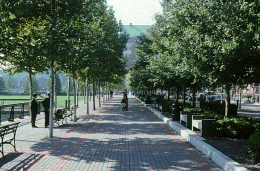
Ms. Saffron commends the State of New Jersey for their requirement for the Hudson River Waterfront Walkway. She also notes the market forces that are shaping the waterfronts of Weehawken, Jersey City and Hoboken, creating revitalized urban neighborhoods that bring life and activity to the public portions of the waterfront. She singles out Hoboken for creating the best of the walkway: “To make sure the new city park was protected from private development, Hoboken laid out a new street — Frank Sinatra Way — to serve as a boundary. Shops, offices and apartments buildings with fabulous views of New York have gone up on the street next to the park, allowing public and commercial spaces to coexist.”
The story she tells about Louisville’s waterfront is similar to what happened in Hoboken. The City of Louisville created a nonprofit waterfront corporation which reached out to the citizens for input. After many public hearings, a consensus was reached that the waterfront should be used for a public park. Since Louisville had 12 parks designed by Frederick Law Olmstead, they conducted a thorough search to find the best talent possible to design their park. They selected landscape architect George Hargreaves who is now the chairman of Harvard University’s School of Design. Hargreaves designed the park to increase the sense of connection between the downtown and the river. Saffron notes that Hargreaves “added a street parallel to the park, as Hoboken did.”
In Hoboken, after voters defeated the City – Port Authority proposal to build a massive 3.2 million square foot project at its south waterfront, then Mayor Patrick Pasculli created the Hoboken Waterfront Corporation (HWC). He appointed both city officials and representatives of local civic groups to this body. HWC spent many months holding community meetings and listening to public input. In the end, HWC redesigned the plan for Hoboken’s waterfront to create a clearly defined public park on the riverside of Sinatra Drive. This conformed to the plan advocated by the Fund for a Better Waterfront, a local advocacy group, creating a continuous waterfront park for the entire 1.5 mile length of Hoboken’s riverfront.
Hoboken then had the foresight to hire landscape architects Henry Arnold and Cassandra Wilday who created an award winning design for Pier A Park and the promenade connecting to Sinatra Park. This design emphasized considerable green space — a grove of trees and an expansive lawn on Pier A, and a triple row of trees closely spaced along the walkway and bike path. Since opening in 1999, this park has become a magnet for people of all walks of life. On warm summer days, Pier A Park is bustling with activity.
Many other communities have sought to emulate the park design at Hoboken’s south waterfront. Inga Saffron’s article in the Philadelphia Inquirer indicates that Hoboken is now getting national attention. The debate over the future of Hoboken’s waterfront, however, continues. The controversies continue over how Block B at the south waterfront, Maxwell House and the Hoboken Cove project will be built. The Fund for a Better Waterfront has continued its advocacy and is pushing to complete key links in the proposed continuous waterfront park at Maxwell House, Stevens (connecting Sinatra Park to Castle Point Park) and elsewhere.
FBW News Archive

